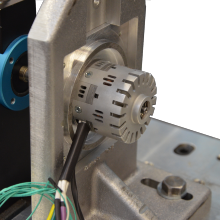Electrical machines in the usual radial design are widely researched and known. Due to ever-increasing demands on torque and power densities and other restrictions on installation space, new paths must be taken in the design of electrical machines. This is where the transition to the axial flux machine comes into its own. It is already widely used in consumer electronics, in the automotive sector, and in automation technology.
The advantages of the axial flux machine are its shortened axial length and efficiency. For the same outer diameter, a higher torque or power density is achieved. This improvement compared to conventional machines is due to a larger air gap area with the same construction volume. The lower iron volume of the active part also results in higher efficiency over a wider speed range. These advantages cause the axial flux machine to be especially attractive in the field of vehicle traction.
Research areas of the axial flux machine lie, for example, in the construction of the stator. The challenge here is to develop a simple construction of the disc-shaped stator with special mechanical strength. Here, the so-called powder composites (SMC) are pointing the way forward in the field of stator construction as well.
At the Institute for Electrical Energy Conversion at the University of Stuttgart, research is being conducted into the application-oriented design and optimization of permanent-magnetically excited axial flux machines. With the help of three-dimensional FEM simulation and numerical optimization, novel manufacturing concepts of the axial flow machine are developed.




